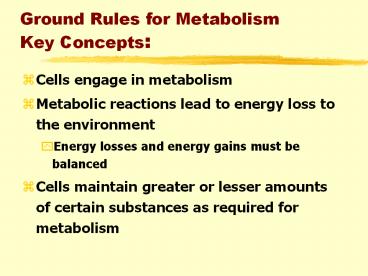Ground Rules for Metabolism Key Concepts: PowerPoint PPT Presentation
1 / 21
Title: Ground Rules for Metabolism Key Concepts:
1
Ground Rules for MetabolismKey Concepts
- Cells engage in metabolism
- Metabolic reactions lead to energy loss to the
environment - Energy losses and energy gains must be balanced
- Cells maintain greater or lesser amounts of
certain substances as required for metabolism
2
Key Concepts (Continued)
- Metabolic reactions release usable energy from
substances to other reactions that require energy - Action of specific enzymes increase the rate of
specific chemical reactions - ATP transports usable energy from one reaction
site to another by the transfer of a phosphate
group
3
Energy and the Underlying Organization of Life
- Metabolism
- Cells capacity to
- Acquire energy
- Build
- Break apart
- Release substances
- Defining Energy
- Potential Energy
- Kinetic Energy
- Heat (Thermal) Energy
- Chemical Energy
4
Defining Energy
- First Law of Thermodynamics
- Energy cannot be created or destroyed
- Second Law of Thermodynamics
- Total amount of energy in the universe is flowing
from higher to lower quality - Entropy
- Systems disorder
5
Energy Inputs Coupled with Outputs
- Exergonic reaction
- Net loss of energy
- Endergonic reaction
- Net increase of energy
- Cells couple reactions
6
Phosphorylation
- Transfer of a phosphate group to a molecule
7
How Does ATP Give Up Energy?
- 5-carbon sugar, base, and triphosphate tail
- Enzymes can break bond between outermost P and
tail, then attach P to another substance
energizing it
8
Electron Transfers Oxidation-Reduction Reactions
- Oxidation - removal of electrons
- Reduction - addition of electrons
9
Electron Transport System
- Array of enzymes coenzymes that transfer
electrons - In cell membranes
- Mitochondria
- Chloroplasts
10
Which way will a reaction run?
- Nearly all chemical reactions in cells are
reversible
A B lt----------gt C
Substrates
Product
11
Chemical Equilibrium
- High reactant concentration - runs strongly
forward - Equilibrium - rate of forward and back reactions
the same - High product concentration - runs strongly in
reverse
12
Metabolic Pathways
- Ordered
- Enzyme mediated
- Biosynthetic or Degradative
13
Enzyme Structure and Function
- Catalysts speed the rate of chemical reactions
- Not permanently altered or used up
- Reversible reactions
- Selective for the substrates
14
Enzyme - Substrate Interactions
- Activation energy
15
Factors Influencing Enzyme Activity
- Temperature
- pH
- Salinity
- Ranges are specific
16
Control of Enzyme Function
- Allosteric control
- Binding of substances on enzyme other than the
active site - Can activate
- Can inhibit
17
Feedback Inhibition
- Shutting down of activity
- Product produced shuts down reaction
- Binds to allosteric site
18
In Conclusion
- Sum of metabolism underlies the survival of
living things - The First and Second Laws of Thermodynamics
affect life - Energy can be converted from one form to another
but cannot be destroyed - Energy flows from higher to lower quality
- Cells balance energy output with input
19
In Conclusion
- Most metabolic reactions proceed in one direction
but some are reversible - Reversible reactions tend toward equilibrium
- Metabolic reactions can release or require energy
- Exergonic reactions end with loss of energy
- Endergonic reactions end with a net gain of energy
20
In Conclusion
- Cells couple exergonic and endergonic reactions
- ATP is the main energy carrier in cells
- ATP forms when a phosphate is donated to ADP
- Metabolic pathways are orderly enzymatically
driven reactions - Enzymes are catalysts, lower activation energy,
and bind substrates
21
In Conclusion
- Enzymes are temperature, pH, and salinity
specific - Cofactors affect enzymes
- Energy conversions in cells involve a flow of
electrons - developed by M. Roig

